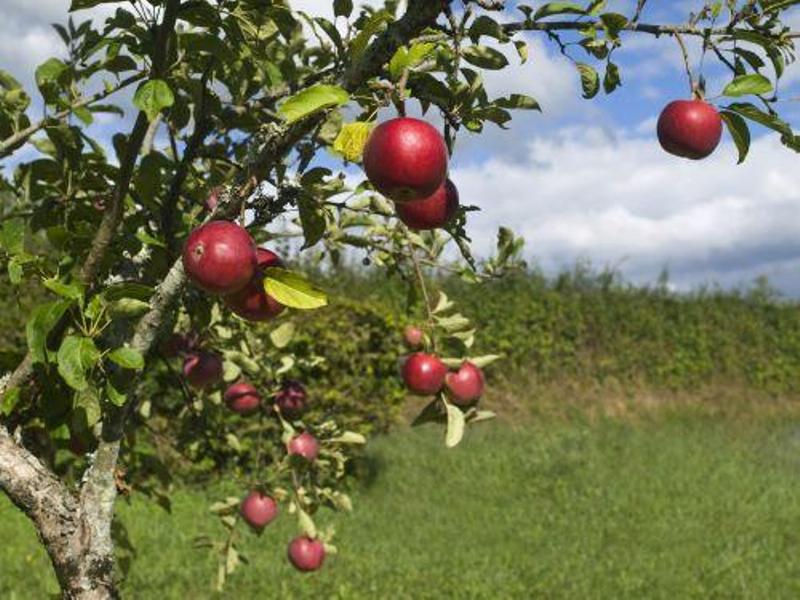Fall is the time for crisp, cool air and the bright colors that come along with the season’s trademark foliage. It’s also the time for you to think about caring for your fruit trees. Even though they’re dormant in late fall and winter, fruit trees are still in need of a little TLC during this period of rest. If you’re in need of some tips for how to care for your fruit trees during the fall season, you’ve come to the right place. Mr. Tree has been caring for trees in the Pacific Northwest for more than 30 years. We have all the tips you need to make sure your fruit trees last through the fall season and beyond.
Inspect Your Trees

This is the time of year that trees shed their leaves. Wait until the leaves are completely off and then carefully inspect your fruit tree. You’ll first want to inspect the tree’s condition to ensure that it’s in good health. If not, you may want to call in a professional arborist for tree service. If the tree appears young and healthy, you’ll want to assess its condition to determine where to prune the tree. Be careful to note that only minimal pruning should be performed in the fall. Leave your major pruning for early spring. If the tree is older, cut off any dead wood or portions of the tree that appear diseased.
Water Well

You should also thoroughly saturate your fruit tree with water just ahead of the winter season. It can be difficult to know exactly how much water to give a tree. That’s why it’s best to place a pan underneath your tree. You can use that pan as a benchmark for how much water your tree needs. Typically, you’ll want to water the tree until you’ve accumulated two or three inches of water in the pan. This will make sure your fruit tree is adequately saturated heading into the winter season.
Avoid Fertilizer

Since your fruit tree goes dormant this time of year, it’s important to avoid doing anything that would encourage its growth. It’s generally a good idea, for instance, to avoid fertilizing your tree during the fall. One exception would be fruit trees that exhibit pale leaves or weak growth. If you do find that fertilizer may be necessary, be sure to avoid using too much.
Clean Up the Leaves

Next, make sure to rake all the leaves away from the tree. This is an important step in preventing the spread of leaf-borne diseases. Make sure to cut the grass around the base of your tree as well. This reduces the habitat of mice, which can be harmful to fruit trees.
Protect Your Trees from Animals, Insects, and Disease

In addition to mice, you’ll also want to take steps to protect your yard or orchard from other animals that may be looking to forage from your trees during wintertime. Deer, for instance, often like to nibble on the bark of young trees. This can cause harm to your fruit trees, so you should do what you can to keep them away. Prior to the start of the winter season, make sure that your fence is secure and unlikely to get damaged by any winter storms. Depending on what animals are drawn to your fruit tree, there are a number of steps that can be taken to keep them away.
For certain types of fruit trees, or trees that have experienced issues with insects or pests in the past, you may want to apply a dormant oil spray. It’s best to apply these sprays when the temperature will be above freezing for several days.
One of the most common diseases affecting fruit trees is peach leaf curl, a fungal disease that afflicts peaches and nectarines. Apple and pear trees can also be prone to fire blight and codling moth. You can find a list of common conditions for a particular type of fruit tree and how to effectively treat them from the Oregon State extension office.
Prepare for Extreme Weather

Extreme weather conditions can threaten the health and structural integrity of your tree. So you should take the proper precautions to protect your fruit tree from winter damage, such as sunscald. This condition occurs when sunlight heats up the tree bark during the day. This warmth causes dormant cells inside the tree to become active. The living cells are then killed by freezing nighttime temperatures, causing damage. Fortunately, there are a number of things you can do to prevent the threat of sunscald.
First, you can wrap the bark of young trees in commercial tree wrap, being careful to remove the wrap in the spring to avoid attracting insects and diseases. You can also paint the trunk of the tree with white latex paint to reflect the sunlight. You can use aluminum foil to shade the tree’s trunk as well. Plastic tree guards are also useful and have the added benefit of being able to protect the tree from mice and rabbits.
Pick the Fruit

If your tree is already bearing fruit, take care to collect any that are damaged or that fall from the tree during the fall/winter seasons. If the fruit is too damaged to eat, you can save it for compost in the spring. Be careful to always wear gloves when collecting fruit in case there are any pests, such as wasps, present.
Fruit trees are a great addition to practically any yard. Growing your own fruit is a wonderful way to make your own homemade pies or handmade products. You can even sell the fruit you grow to turn a profit. But in order to ensure your fruit tree has a plentiful harvest, you’ll have to provide it with the proper care. If you want to make sure your fruit tree will survive the winter season, give us a call to schedule a tree service appointment. After all, we want to make sure you enjoy the fruits of your labor, literally and figuratively, for years to come!


















